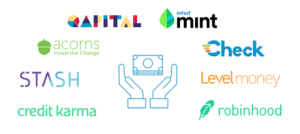An explosion of new consumer finance brands is transforming how people save, spend, and manage their money. Ninety-two million millennials will soon be in what Goldman Sachs calls their “prime spending years.” In aggregate, they command $1.3 trillion in annual spending. They have a deep antipathy to traditional financial institutions.
by Liz Rustia
A host of startups have emerged to capitalize on this trend. These companies are making it easier to make a budget, invest, and buy stocks, as well as to get loans and credit cards.
The leading apps in personal finance

Robinhood – buy and sell stocks and exchange-traded funds (ETFs) without paying a commission. With the use of white space and referral program, Robinhood got million users in days.
Level Money – aims to track your “spendable” money—i.e. the amount that’s left over after you’ve paid all fixed expenses and set aside some money for savings. Effortless personal financial control and new models for financial services. Instead of categorizing transactions and tracking bank balances, Level empowers members to easily understand cash flow by automatically detecting income and fixed expenses from linked financial accounts.
Credit Karma – online personal-finance platform that lets you monitor your credit reports and scores for free and offers other tools and services based on your profile. Credit Karma provides free weekly updated credit reports and scores as well.
Stash – The Stash Invest app allows investors to start investing with as little as $5. Not only that, but Stash makes choosing investments extremely simple. They also have low fees at only $1 per month if your account has less than $5,000 or 0.25% per year if your account holds more than $5,000.
Acorns – Painless saving by investing your spare change. The service is free and pricing starts at just $1 per month for pretty much everyone else. You can set up your Acorn app to automatically invest your savings without your even knowing about it.
Qapital – Qapital adds the option to automatically transfer money, based on rules you choose, to an FDIC-insured Wells Fargo account. The app also enables you to share your goals with your family, friends or teammates, to help you stay on track with those goals. So you can use peer pressure to continue your savings plan.
Mint and Mint Bills (formerly Check and before that Pageonce) – lets users link all of their financial accounts in one place and pay bills directly from the app. Allows users to track bank, credit card, investment, and loan balances and transactions through a single user interface, as well as create budgets and set financial goals.
Understanding the dynamics of user acquisition and growth
To build a successful personal finance management tool, it’s important to understand the dynamics of user acquisition and growth.
Building a product that people want is hard. It’s even harder when your target market would rather never think about what you’re trying to sell them — retirement, for example. (Bankrate found 83% of millennials don’t think they’ll ever retire: they simply “don’t think they’ll have the money” to do so.)
The result of getting your product right, however, can be exponential growth so fast it’s hard to wrap your mind around. Below are some examples on what they did to achieve their massive results.
- How to use pre-launch marketing to build trust and hype
- How blog posts helped Mint get 20,000+ customers pre-launch
- How Robinhood used an ingenious referral program to build a 1M+ customer waitlist
- How to show value during the first-run experience
- The free tools Credit Karma uses to drive a sticky experience and bring 5M+ users from Google every month
- How Mint returns 100+ lost hours to its users’ lives right away
- The 3 questions Level Money asks users the first time they use the app
- How to design for the specific user you want
- Robinhood’s clutter-free user interface design is flypaper for millennial audiences
- How narrowing its feature roadmap helped Check get acquired for $360M
- How the color green helped Mint convert more potential users
- How Level Money designed a millennial-friendly, mobile-first experience
- How to monetize your users’ financial betterment
- The $2B opportunity Mint found in preferred pricing
- How Credit Karma built a $500M business by helping people
- Why Qapital is building an all-in-one PFM suite
- How Robinhood launched crypto and got a million new users in days
- How to productize personal responsibility
- How recurring micro-transactions let Acorns do 17x the trading volume of Fidelity
- Stash’s strategy around choice and how it helps them add 25,000 users a week
- The behavioral science behind Qapital’s trigger-based investing
- How to turn sharing into self-improvement
- The addictive referral program driving Robinhood’s continued growth
- Stash teaches its users how to invest
- Acorns’ rock-bottom customer acquisition costs as driven by non-viral referral
With patience, continuous user engagement and maximizing the tactics above ensure regular traffic to any apps. Still want to read more of how these companies strategized their success? Click here.
Share this article on